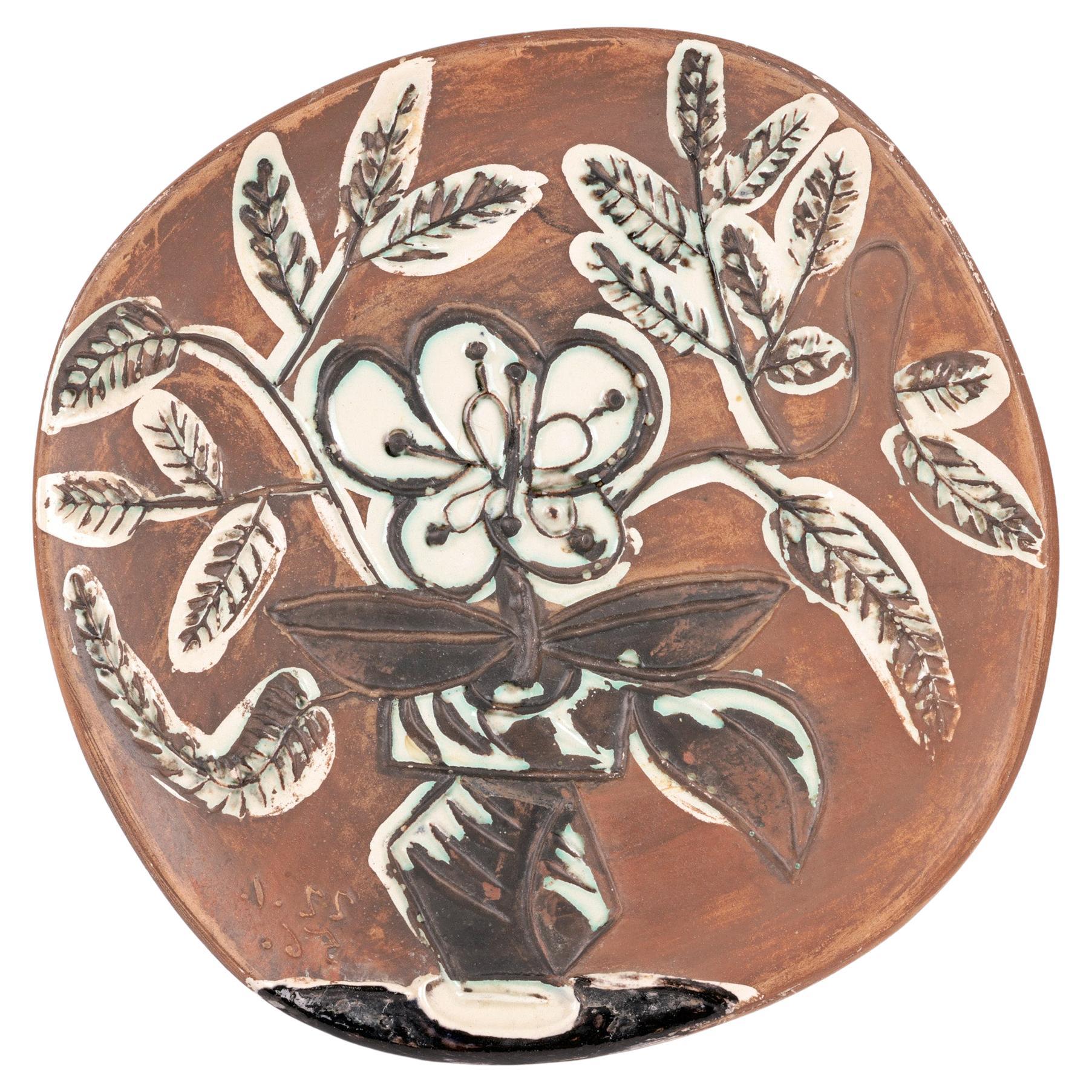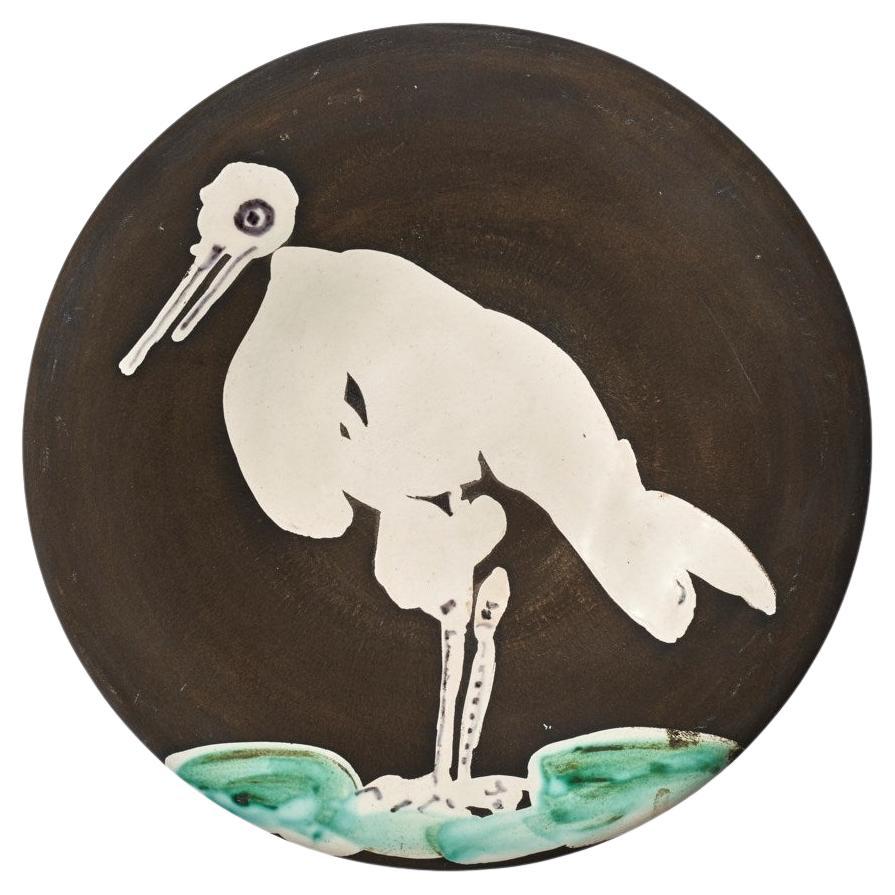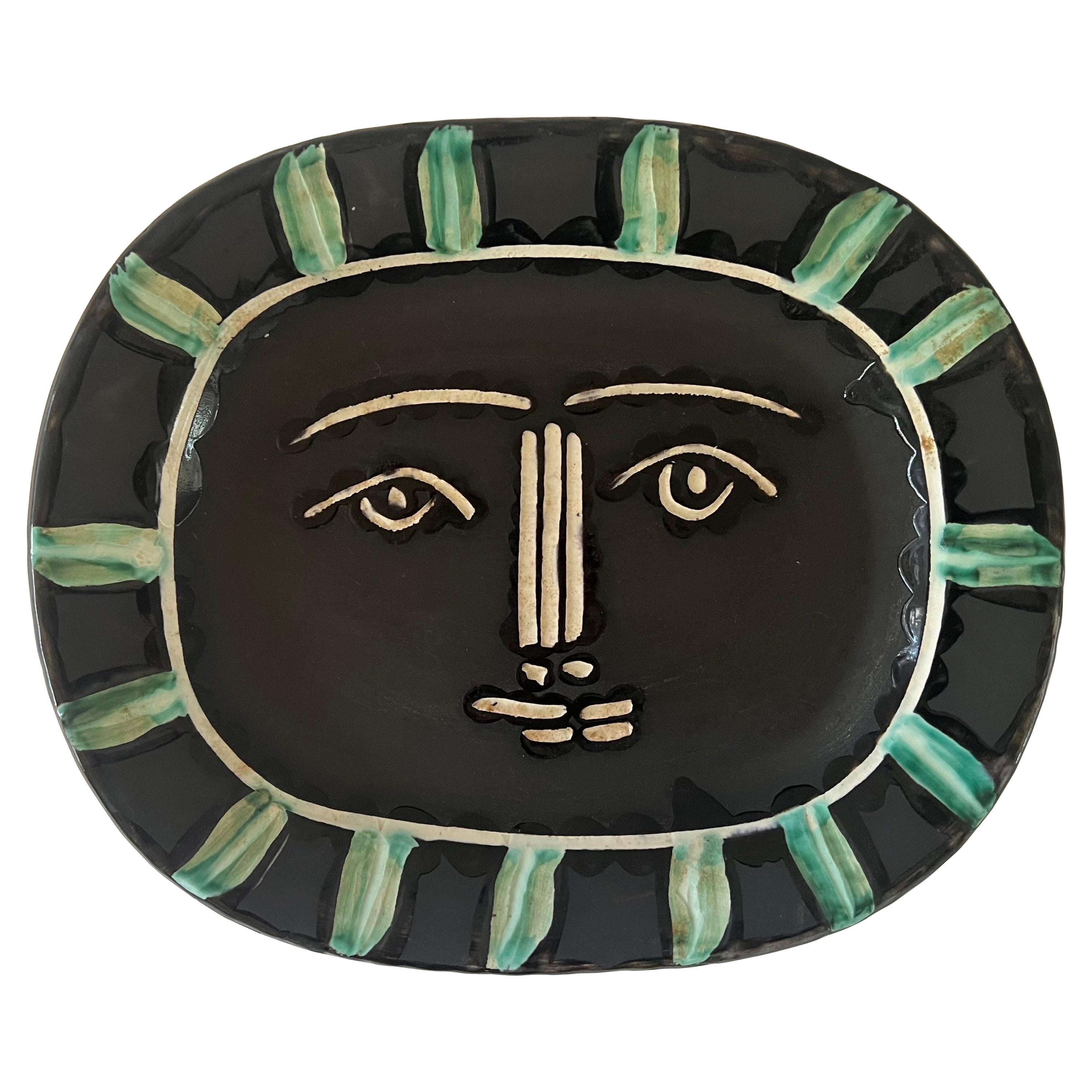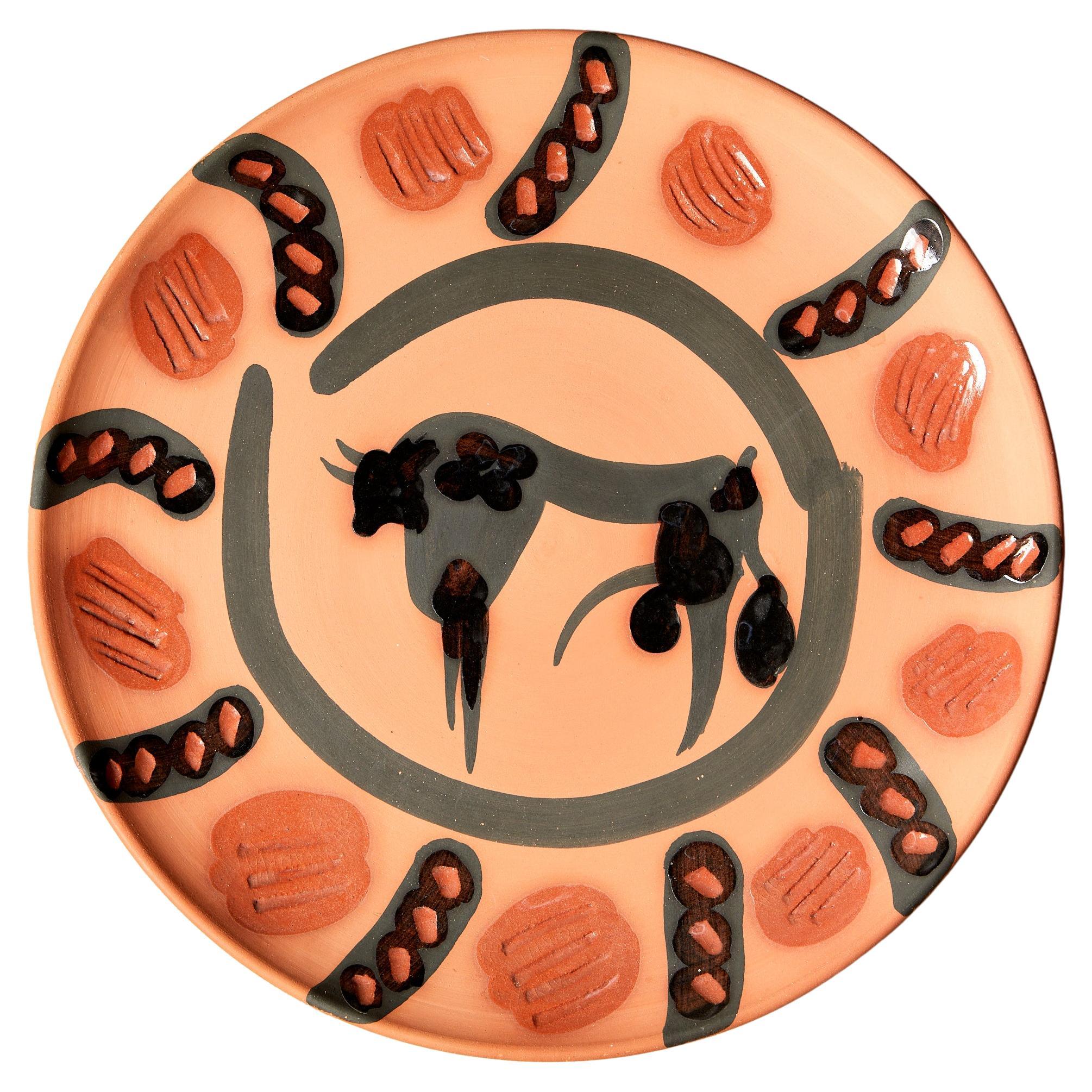Pablo Picasso Arrastro A.R. 431 Limited Edition Ceramic Dish No. 14/50
About the Item
- Creator:Pablo Picasso (Artist)
- Dimensions:Height: 1.28 in (3.25 cm)Diameter: 16.15 in (41 cm)
- Style:Mid-Century Modern (Of the Period)
- Materials and Techniques:
- Place of Origin:
- Period:
- Date of Manufacture:1959
- Condition:Wear consistent with age and use.
- Seller Location:Bishop's Stortford, GB
- Reference Number:
Pablo Picasso
One of the most prolific and revolutionary artists the world has ever seen, Pablo Picasso had a tremendous impact on the development of 20th-century modern art. Although he is best known for his association with the Cubist movement, which he founded with Georges Braque, Picasso’s influence extends to Surrealism, neoclassicism and Expressionism.
“Every act of creation is, first of all, an act of destruction,” the Spanish artist proclaimed. In Picasso's Cubist paintings, he emphasizes the two-dimensionality of the canvas, breaking with conventions regarding perspective, foreshortening and proportion. Picasso was inspired by Iberian and African tribal art. One of his most famous pre-Cubist works is Les Demoiselles d’Avignon (1907), a painting considered immoral and shocking at the time for its depiction of nude women whose faces resemble Iberian tribal masks.
Picasso made many portraits in this style, most often of the women in his life, their expressively colored faces composed of geometric shards of surface planes. In Woman in a Hat (Olga), 1935, he painted his first wife as an assemblage of abstract forms, leaving the viewer to decipher the subject through the contrasting colors and shapes. Picasso was a tireless artist, creating more than 20,000 paintings, drawings, prints, ceramics and sculptures. Tracing his life’s work reveals the progression of modern art, on which he had an unparalleled influence.
Browse an expansive collection of Pablo Picasso's art on 1stDibs.
- ShippingRetrieving quote...Ships From: Bishop's Stortford, United Kingdom
- Return PolicyA return for this item may be initiated within 14 days of delivery.
- Pablo Picasso Vase au Bouquet A.R. 303 Limited Edition Ceramic Dish No. 40/300By Pablo PicassoLocated in Bishop's Stortford, HertfordshireA stylish Vase au Bouquet (A.R. 303) ceramic limited-edition dish decorated with a vase containing a flower by Pablo Picasso (Spanish, 1881-1974) and dated 22nd January 1956. The squ...Category
Vintage 1950s Spanish Mid-Century Modern Ceramics
MaterialsClay, Earthenware
- Pablo Picasso Vallauris A.R. 330 Limited Edition Plate With Three Faces, 1956By Pablo PicassoLocated in Bishop's Stortford, HertfordshireA stylish Vallauris (A.R. 330) terre de faience limited edition plate portraying three faces by Pablo Picasso and dated 1956. The rounded plate i...Category
Mid-20th Century French Mid-Century Modern Ceramics
MaterialsEarthenware
- Pablo Picasso Dish, Corrida White Earthenware Dish 1953 'A.R.182'By Pablo PicassoLocated in Bishop's Stortford, HertfordshireTerre de faïence dish, 1953, from the edition of an unknown size (Alain Ramié states that only a few copies of this subject were produced). The dish is centrally decorated with a ...Category
Vintage 1950s European Mid-Century Modern Pottery
MaterialsEarthenware, Pottery
- Pablo Picasso, Scène De Tauromachie Dish 'A. R. 412'By Pablo PicassoLocated in Bishop's Stortford, HertfordshireTerre de faïence dish 1959 numbered 52/100 and incised 'Empreinte Originale de Picasso' & 'Madoura' stamps. The dish is centrally decorated with a scene comprising of a matador br...Category
Vintage 1950s European Mid-Century Modern Pottery
MaterialsPottery
- Pablo Picasso Drawing 'Pours Mes Chers Fiancés, ' 1956By Pablo PicassoLocated in Bishop's Stortford, HertfordshireA unique vintage Pablo Picasso (Spanish, 1881-1973) framed, signed and inscribed title page of L'Oeuvre Gravé de Picasso dedicated and presented to the engaged couple Sylvette David and Tobias Jellinek, who married later in 1956 with original pastel sketches of the couple below a signed dedication reading 'Pour mes chers fiances' dated to the upper left corner 20.4.56. Provenance: Given by Pablo Picasso to Sylvette David and Tobias Jellinek on their engagement and who later married; thence sold to Eila Grahame. Other notes: "In 1956 the art periodical, Verve, had an image of Sylvette on the cover and Sylvette and I were given a copy. We went to see Picasso that day and took the book with us, and asked Picasso if he would sign it for us. He went and found some colored crayons and wrote the dedication, adding the little sketch of us both. The likeness of Sylvette shows how comfortable he was with producing her image, which he had previously worked with for several months. His drawing of me with my new beard is less of a likeness!" Tobias Jellinek, April 2017. Pablo Picasso had been working on a portrait of Sylvette David, aged 19, as the girl with the ponytail before doing the present cartoon sketch. "Sylvette" is the title of one of Picasso's numerous paintings featuring a young woman with a ponytail. The model for the painting, Lydia Sylvette David, also known later by her married name Lydia Corbett...Category
Vintage 1950s European Mid-Century Modern Drawings
MaterialsCrayon, Paper
- Studio Pottery Slipware Fish Decorated Terracotta DishLocated in Bishop's Stortford, HertfordshireA stylish British studio pottery dish decorated with a slipware fish design in the manner of Winchcombe and signed Gilbert dating from the 20th century. The oval shaped dish narrows ...Category
20th Century English Mid-Century Modern Ceramics
MaterialsTerracotta
- Pablo Picasso Ceramic Plate 'Oiseau No.83'By Pablo PicassoLocated in Paris, FRWhite earthenware ceramic plate with colored engobe and glaze. Marked and numbered 'No 83 / Edition Picasso / 30/ 200 / Madoura' (underneath). (A.R. 483).Category
Vintage 1960s Ceramics
MaterialsCeramic
- Ceramic Plate Visage Gris 'Grey Face' A.R. 206 by Pablo Picasso & Madoura, 1953By Madoura, Pablo PicassoLocated in New York, NYThe engraved and brush painted ceramic plate, Visage Gris (Grey Face) is one the most iconic pieces created by Pablo Picasso (1881 - 1973) at the Madoura workshop in Vallauris, France. It is said "all portraits are self portraits". In this work, we see Picasso's wistfulness, vulnerability and humor set within a beautiful image representing both the sun and the moon, the masculine and the feminine. Picasso mastery of form, image, composition and subtle color is evident in a work that resonates transcendence. Created in 1953, Pablo Picasso ceramic Visage Gris (Grey Face), 1953 A.R. 206 is a Madoura white earthenware clay, knife engraved under partial brushed glaze with decoration in engobes (green, black, white) from the edition of 500. This work is stamped with the 'Madoura PLEIN FEU' and ‘EMPREINTE ORIGINALE DE PICASSO’ pottery stamps on the reverse. Dimensions: 12 3/8 x 15 1/8 x 1 5/8in (31.4 x 38.3 x 4.1cm). Madoura was an artisan workshop created by Georges and Suzanne Ramie which collaborated with Picasso in the fabrication and hand painting of the works. Pablo Picasso designed 633 different ceramic editions between 1947 and 1971 at the Madoura workshop, with a number of variants and unique pieces resulting from these initial works. He began by creating simple, utilitarian objects such as plates and bowls, but later produced more complex forms, including pitchers and vases — their handles occasionally shaped to form facial features, or anatomical parts of his animal subjects. Picasso remains one of the highest-grossing artists at auction today, and the range of his ceramics means it's possible to find both a good investment and a beautiful object. Visage Gris is among the most important. A Short Biography follows: Pablo Picasso revolutionized the art world and to many is THE artist of the 20th century. He is famous for his role in pioneering Cubism with Georges Braque and for his melancholy Blue Period pieces. Original signed Picasso lithographs and prints are a sure investment. Madoura Picasso ceramics are highly collectible in their own right. As one of the most influential Modern artists of the 20th century, Pablo Picasso is renowned as a legendary artistic master to this day. Born on October 25, 1881 in Malaga, Spain, Pablo Picasso was a child prodigy who was recognized as such by his art-teacher father, who ably led him along. The small Museo de Picasso in Barcelona is devoted primarily to his early works, which include strikingly realistic renderings of casts of ancient sculpture. Picasso was a rebel from the start and, as a teenager, began to frequent the Barcelona cafes where intellectuals gathered. He soon went to Paris, the capital of art, and soaked up the works of Edouard Manet, Gustave Courbet, and Henri de Toulouse-Lautrec, whose sketchy style impressed him greatly. Then it was back to Spain, a return to France, and again back to Spain – all in the years 1899 to 1904. Before he struck upon Cubism, Picasso went through a prodigious number of styles – realism, caricature, the Blue Period, and the Rose Period. These distinguished styles are apparent in the unique original works as well as Picasso ceramics, lithographs, linocuts, and etchings that he created later in his life. The Blue Period dates from 1901 to 1904 and is characterized by a predominantly blue palette and focuses on outcasts, beggars, and prostitutes. This was when he also produced his first sculptures. The most poignant work of the style, La Vie (1903), currently located in Cleveland’s Museum of Art, was created in memory of his childhood friend, the Spanish poet Carlos Casagemas, who had committed suicide. The painting started as a self-portrait, but Picasso’s features became those of his lost friend. The composition is stilted, the space compressed, the gestures stiff, and the tones predominantly blue. The Rose Period began around 1904 when Picasso’s palette brightened and is dominated by pinks and beiges, light blues, and roses. His subjects are saltimbanques (circus people), harlequins, and clowns, all of whom seem to be mute and strangely inactive. One of the premier works of this period is Family of Saltimbanques (1905), currently in Washington, D.C. at the National Gallery, which portrays a group of circus workers who appear alienated and incapable of communicating with each other, set in a one-dimensional space. In 1905, Picasso went briefly to Holland, and on his return to Paris, his works took on a classical aura with large male and female figures seen frontally or in distinct profile, as in early Greek art. One of the best examples of this style is in the Albright-Knox Gallery in Buffalo, NY, La Toilette (1906). Several pieces in this new, classical style were purchased by Gertrude Stein (the art patron and writer) and her brother, Leo Stein. With his groundbreaking 1907 painting Les Demoiselles d’Avignon...Category
Mid-20th Century French Mid-Century Modern Figurative Sculptures
MaterialsEarthenware
- Pablo Picasso, Bull, Turned round dish, 1957, edition of 250 copies.By Pablo PicassoLocated in Nice, Cote d' AzurPablo Picasso Taureau 1957. 22 janvier Plat rond tourné D. 38 cm R.A terre de faience rouge, décor à l'engobe, gravé au couteau, couverte partielle au pinceau Noir Tiré à 250 exemp...Category
Vintage 1950s French Modern Ceramics
MaterialsCeramic
- Pablo Picasso Ceramic pitcher 'Visage'By Pablo PicassoLocated in Paris, FRWhite earthenware ceramic pitcher with colored engobe and glaze. Stamped ‘Madoura Plein Feu/EditionPicasso’ (underneath). (A.R. 288)Category
Vintage 1950s Ceramics
MaterialsCeramic
- Ceramic Plate by Pablo Picasso, 1953By Pablo PicassoLocated in Hamburg, PACorrida sur fond noir ceramic plate by Pablo Picasso dated "25.9.53" stamped and marked "Madoura Plein Feu/Edition Picasso/D'Apres Picasso" (unde...Category
Vintage 1950s European Mid-Century Modern Ceramics
MaterialsCeramic
- Pablo Picasso White Ceramic Plate 'Plongeurs'By Pablo PicassoLocated in Paris, FRWhite earthenware ceramic plaque with black oxide and white glaze. Stamped 'Madoura Plein Feu/Empreinte Originale de Picasso' (on the reverse). (A.R. 377).Category
Vintage 1950s Ceramics
MaterialsCeramic
Recently Viewed
View AllRead More
Science Uncovers Hidden Truths behind Young Pablo Picasso’s Blue Period
From 1901 to 1904, Picasso limited his palette to bluish hues in producing some of his most famous early works. A new show looks at the recycled materials, hidden underpaintings, surprising influences and bohemian lifestyle that led to their creation.
Who Are the Most Popular Artists on 1stdibs?
Learn the stories of some of the world's most recognizable artworks and their makers.






